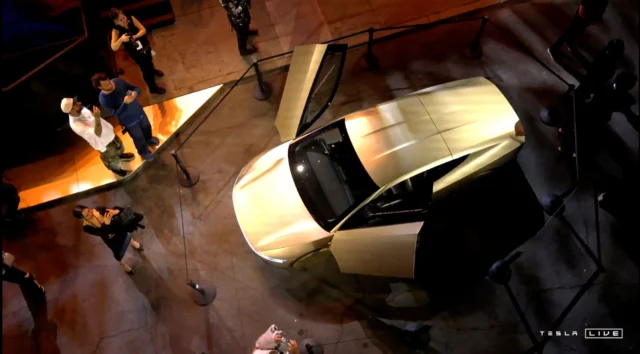Tesla’s chief executive, Elon Musk, presented the automaker’s long-awaited autonomous car on Thursday night, equipped with two gull-wing doors and no steering wheel or pedals, and surprised the public with a robot, betting on a investor focus shift from mass cars to robotic vehicles.
Musk entered the stage in a “Cybercab”, promising that the vehicle will begin production from 2026 with a price below US$30,000. Then, the billionaire presented an autonomous van, capable of transporting up to 20 people, although he gave few details about it.
The executive did not say how quickly Tesla could increase production of self-driving cars, overcome the inevitable regulatory hurdles or implement a business plan to overtake rivals like Alphabet’s Waymo.
READ MORE: Tesla cars made in China will have reduced extra tax, defines European Union
Industry analysts and experts said the use of driverless cars could take years to be fully cleared by authorities, especially given the guarantee of safety and reliability. The first fleets have already suffered accidents, some serious, including being run over. According to experts, current technology still has difficulty responding to adverse scenarios including unfavorable weather conditions, complex intersections and unpredictable pedestrian behavior.
But Musk, wearing a leather jacket and addressing a crowd at the Warner Bros. studio near Los Angeles, said self-driving cars could be 10 times safer than those driven by humans.
“The autonomous future is here,” said Musk. “With autonomy, you get your time back.”
Musk had previously said he planned to operate a fleet of self-driving Tesla taxis that passengers could hail via an app. Tesla car owners could also make money with the app by listing their vehicles as robotaxis on the platform, the executive said. But at Thursday’s event the billionaire made no mention of the app.
READ MORE: Cruise will offer autonomous vehicles through Uber in the US from 2025
The event — titled “We, Robot,” in an apparent reference to Russian-American writer Isaac Asimov’s science fiction short stories “I, Robot” — echoed Musk’s comment that Tesla “should be considered an AI-enabled robotics company” rather than a car manufacturer.
The presentation, which had been in the works for months, lasted less than half an hour and was watched by around four million people on social media platform X alone.
“I am a shareholder and I am very disappointed. I think the market wanted more definitive deadlines,” said stock trader Dennis Dick of Triple D Trading. “I don’t think he said much about anything.”
The Cybercab will cost 20 cents per mile to operate over time and charging will be inductive, with no plugs required, Musk said. Operating the autonomous vans will be even cheaper – 5 cents per mile.
READ MORE: What’s behind the accidents involving Tesla’s Autopilot
Tesla’s driverless vehicles will feature artificial intelligence and cameras, rather than the lidar sensors present in rivals’ self-driving cars – an approach that experts point to as challenging from both a technical and regulatory perspective.
In addition to the vehicles, Musk praised “a lot of progress” made by the company on the humanoid robot “Optimus”, which could have a price of US$20,000 to US$30,000 and which, according to the billionaire, will be able to perform many daily tasks.
Complicated market
Musk said in 2019 that he was “very confident” that Tesla would have operational autonomous taxis by 2020. This year, he shifted focus to the Cybercab and scrapped plans to develop a smaller, cheaper car, widely seen by the market as essential to combat the slowdown in demand for electric vehicles.
Tesla is at risk of its first sales drop this year as purchasing incentives have failed to attract enough customers, according to Reuters calculations based on the company’s figures.
Several companies that have attempted to enter the driverless taxi market have suffered billions of dollars in losses. Some even closed their doors.
Alphabet’s Waymo, with about 700 Jaguar Land Rover cars in its fleet, is the only U.S. company that operates unmanned robo-taxis that charge fares to passengers.
Amazon’s Zoox is testing purpose-built vehicles that do not have manual controls. General Motors’ Cruise, which uses the Chevrolet Bolt, indefinitely suspended plans this year to develop the “Origin” autonomous vehicle without pedals or a steering wheel.
Tesla’s approach to fully autonomous driving technology, in its current iteration, requires constant driver attention but keeps costs low. However, it has faced lawsuits following at least two fatal accidents involving cars equipped with the technology.
“We hope to launch fully autonomous unattended FSD in Texas and California next year,” Musk said. “That will be with the Model 3 and Model Y.” He did not say whether Cybercab uses FSD or new technology.
“There are still a lot of questions about how this will be achieved from a practical standpoint,” said Jessica Caldwell, director of car research and purchasing site Edmunds, about the autonomous vehicles presented by Musk.






